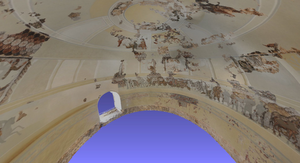Information
- Publication Type: Master Thesis
- Workgroup(s)/Project(s):
- Date: May 2012
- Date (Start): 11. August 2010
- First Supervisor: Michael Wimmer
Abstract
Archaeological monuments are nowadays preserved for future generations by means of digitization. To this end, laser scanners in conjunction with registered cameras are used to gather both the geometric and the color information. The geometry is often triangulated to allow a continuous mapping of the photos onto the geometry. The color mapping for high-quality reconstructions of parts of the models is not without problems. In practice, the photos overlap. Now, assuming that a particular triangle receives color information from just one photo, there is a huge number of possibilities to map the photos onto the triangles. This labeling problem is already covered in literature. There are also approaches for the leveling of the remaining seams that arise because of the different lighting situations during the exposure of the photos. In this thesis, we improve common labeling approaches by the introduction of an accurate geometry-based occlusion detection. An octree is used to quickly filter out parts of the model that do not come into consideration for an occlusion anyway. The occlusion detection prevents texturing of parts of the model with image material that does not contain the expected region, but the colors of an occluder.Further, a proposed approach for seam leveling on meshes is improved by the introduction of a new term into the least squares problem that corresponds to the proposed leveling approach. This new term penalizes big leveling function values and helps to keep the leveled color values in the valid range. For better filtering results, we improve the proposed calculation of a 1-pixel wide boundary around the leveled patches by the introduction of outline normals for a user-defined scale of the patches.
For easier manual editing of remaining artifacts in the photos, we introduce an application for the generation of alpha masks that indicate regions of the photos that are used for texturing of the 3D model.
For the high-performance visualization of 3D models with a huge amount of textures, we make use of virtual texturing. We present an application that generates the needed data structures atlas and tile store in significantly less time than existing scripts.
Finally, we show how all the mentioned functionalities are integrated into a visualization application that can support a graphic artist in the post-processing of a digitized archaeological monument.
Additional Files and Images
Weblinks
No further information available.BibTeX
@mastersthesis{Birsak-Michael-2012,
title = "Coloring Meshes of Archaeological Datasets",
author = "Michael Birsak",
year = "2012",
abstract = "Archaeological monuments are nowadays preserved for future
generations by means of digitization. To this end, laser
scanners in conjunction with registered cameras are used to
gather both the geometric and the color information. The
geometry is often triangulated to allow a continuous mapping
of the photos onto the geometry. The color mapping for
high-quality reconstructions of parts of the models is not
without problems. In practice, the photos overlap. Now,
assuming that a particular triangle receives color
information from just one photo, there is a huge number of
possibilities to map the photos onto the triangles. This
labeling problem is already covered in literature. There are
also approaches for the leveling of the remaining seams that
arise because of the different lighting situations during
the exposure of the photos. In this thesis, we improve
common labeling approaches by the introduction of an
accurate geometry-based occlusion detection. An octree is
used to quickly filter out parts of the model that do not
come into consideration for an occlusion anyway. The
occlusion detection prevents texturing of parts of the model
with image material that does not contain the expected
region, but the colors of an occluder. Further, a proposed
approach for seam leveling on meshes is improved by the
introduction of a new term into the least squares problem
that corresponds to the proposed leveling approach. This new
term penalizes big leveling function values and helps to
keep the leveled color values in the valid range. For better
filtering results, we improve the proposed calculation of a
1-pixel wide boundary around the leveled patches by the
introduction of outline normals for a user-defined scale of
the patches. For easier manual editing of remaining
artifacts in the photos, we introduce an application for the
generation of alpha masks that indicate regions of the
photos that are used for texturing of the 3D model. For the
high-performance visualization of 3D models with a huge
amount of textures, we make use of virtual texturing. We
present an application that generates the needed data
structures atlas and tile store in significantly less time
than existing scripts. Finally, we show how all the
mentioned functionalities are integrated into a
visualization application that can support a graphic artist
in the post-processing of a digitized archaeological
monument.",
month = may,
address = "Favoritenstrasse 9-11/E193-02, A-1040 Vienna, Austria",
school = "Institute of Computer Graphics and Algorithms, Vienna
University of Technology ",
URL = "https://www.cg.tuwien.ac.at/research/publications/2012/Birsak-Michael-2012/",
}

 Poster
Poster Thesis
Thesis


